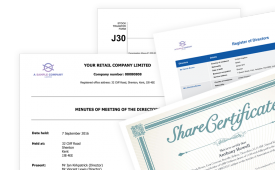An ERN (Employer Reference Number) is issued to every UK company that registers as an employer. It is also referred to as a PAYE reference number because it is used as a unique identifier by HMRC when processing payroll information, such as income tax and National Insurance. It is used to collect taxes, ensure that the business pays the correct amounts to HMRC and monitor compliance. An ERN is included in the welcome pack HMRC sends out to each newly registered employer.
Every business must register as an employer with HMRC as soon as it hires its first employee on Pay As You Earn (PAYE).
What does an ERN look like?
The employer reference number is in two parts. The first part is three digits, which identifies the HMRC office number that deals with the company’s PAYE (e.g. 135). The second part of the reference, which follows a forward slash, is the tax office’s unique reference for the employer (e.g. AB56789). The letter or letters in the ERN should be entered in upper case.
A business registered as an employer before 2001 will have an employer reference number in the form 135/A56789. In 2001 an extra letter was added, therefore ERNs registered after that date will take the form 135/AB56789.
The vast majority of businesses will have a single employer reference number. However, if you operate separate PAYE schemes for different business locations, you may have more than one ERN.
A better way to manage company secretarial work
Inform Direct is the perfect tool to help make company secretarial work a whole lot easier:
> Monitor company deadlines
> Manage details of officers, PSCs and shares
> Easy filing of forms with Companies House
> Automatic updates to statutory registers
> Create documents from 400+ templates
Which businesses are exempt from needing an employer reference number?
The only ERN-exempt companies are those who do not operate a PAYE scheme because they:
- have no employees
- only have people working in the business who are self-employed, paid by an agency or volunteers
- have employees who are all paid below the Lower Earnings Limit and none of whom has another job or is in receipt of a pension or benefits
- are registered outside England, Wales, Scotland & Northern Ireland, e.g. in Jersey, Guernsey & the Isle of Man
If you’re at all unsure whether these exceptions apply to your company, you should consult your accountant or HMRC directly.
When do I need my ERN?
- When completing the annual PAYE return. HMRC will usually reject the submission without your ERN.
- When an employee asks you for it. They will need it to complete an application for tax credits, Universal Credit or student loan, for example. It’s also required to support a claim for tax relief on employment expenses submitted via form P87. They may also need it when talking to HMRC about their tax affairs more generally. If someone is employed by more than one company, they will have a different PAYE reference number for each employer.
- When taking out employer’s liability insurance. It has been a legal obligation for employers to have this since the Employers’ Liability (Compulsory Insurance) Act 1969. ERNs are recorded on a database run by the Employers’ Liability Tracing Office (ELTO). This exists to give employees easy access to their present and previous employers’ employers’ liability insurance data, even after years have passed since the employment ended. The aim is to ensure that claims are settled with the insurer which covered the company at the time rather than the employer.
- In correspondence with HMRC about income tax and National Insurance.
- It should be quoted on P60s, P11Ds and P45s. Many employers choose also to include it on payslips, although it is not a legal requirement to do so.
Your ERN shouldn't be confused with your:
- Company registration number (CRN), issued by Companies House on incorporation of every company. It consists of eight characters: eight digits or two letters followed by six digits. It is used when filing at Companies House. It can be found, among other places, on your certificate of incorporation.
- VAT number, issued by HMRC to companies who register for Value Added Tax. It consists of nine digits, sometimes with ‘GB’ added at the start.
- Unique taxpayer reference (UTR), issued by HMRC to self-employed people and consisting of 10 digits. Used when dealing with affairs such as tax returns, tax refunds etc. In partnerships, each partner needs their own UTR.
- Companies House authentication code, a 6-character alphanumeric code provided by Companies House upon company registration. It acts as your electronic signature to allow you to file submissions with Companies House. It will be something like A1BC2D.
Where can I find my ERN?
You should be able to find your employer’s reference number in the following places:
- In the booklet supplied by HMRC in your welcome pack when you first registered as an employer
- On any P45, P60 or P11D issued to past or present employees. Sometimes the ERN is also included on payslips
- Other correspondence from HMRC about PAYE
- Your accountant or bookkeeper, if you outsource your payroll
- As a last resort, you can call HMRC’s Employer Helpline on 0300 200 3200. While they can resend the reference to the employer, it may take up to two weeks to arrive.
If you don’t have any record of an employer reference number, it may be because you are not registered as an employer. That’s no problem if the business doesn’t employ anyone. If it does employ staff, and they are paid above the PAYE tax threshold, it’s imperative that you register immediately with HMRC.

Inform Direct makes it easy to manage company records, statutory books and Companies House filings
This article was originally published in 2015. The most recent revision was in April 2024.

